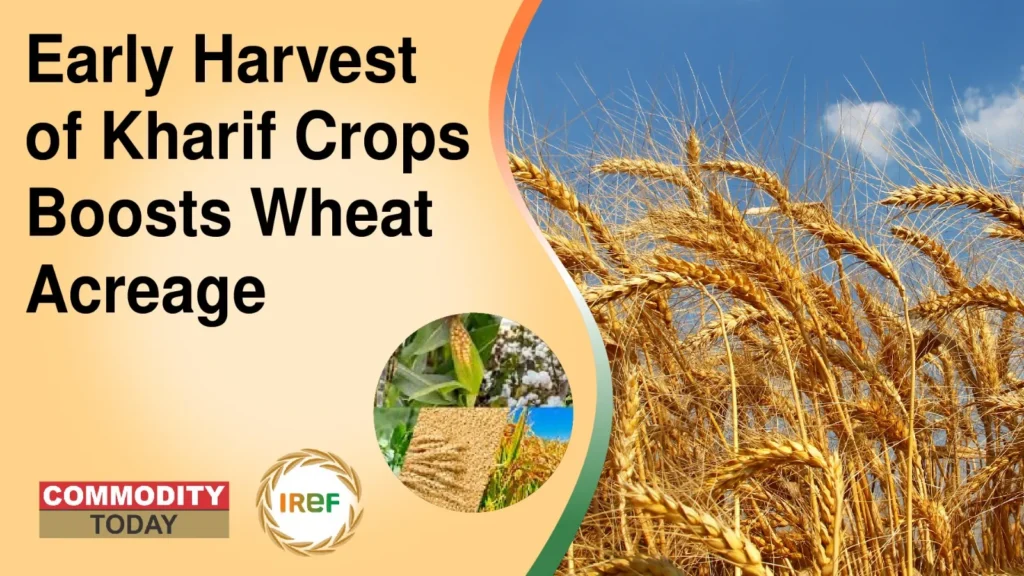Kharif crops harvested on time this year have given India’s farmers a head starts for the Rabi season, with wheat acreage more than double compared to last year. Thanks to the early harvest and rapid field clearance, total crop sowing under all Rabi crops has surged by 27%, covering over 130 lakh hectares (lh) as against 102 lh a year ago — signaling strong momentum in agriculture growth and farm output.
Early Gains for Wheat Cultivation and Crop Yield
The timely harvest of Kharif crops like paddy has paved the way for early wheat cultivation, especially in Punjab, Haryana, and Uttar Pradesh. Official data show that nearly 93% of paddy has been harvested in Punjab and 78% in Haryana, while over half of the paddy fields in Uttar Pradesh have already been cleared for wheat planting as of November 9.
The government has targeted 171.14 million tonnes (mt) of foodgrain production this Rabi season, including 119 mt of wheat production, 15.86 mt of rice, 16.57 mt of pulses, and 15.07 mt of oilseeds. Experts believe the early sowing and favorable weather conditions could help achieve or surpass these targets, ensuring better crop yield and farm income for wheat farmers.
Advisory for Wheat Farmers on Timely Sowing
The Karnal-based Indian Institute of Wheat and Barley Research (IIWBR) has advised farmers to choose wheat varieties carefully based on sowing time and local conditions to maximize crop yield. The institute emphasized purchasing certified seed from reliable sources and recommended machine sowing to save time, labor, and seed.
“In combine-harvested paddy fields, direct wheat seeding can be done using Happy Seeder or Smart Seeder machines in the presence of crop residue,” the advisory stated. “Avoid delays in sowing to prevent yield losses due to potential heat stress at maturity.” Farmers have also been cautioned against using varieties from other zones to avoid disease susceptibility. Seeds should be treated with Carboxin 75 WP (2.5 g/kg), Carbendazim 50 WP (2.5 g/kg), or Tebuconazole 2DS (1.25 g/kg) before planting.
Broader Growth in Crop Acreage and Farm Output
Apart from wheat, other Rabi crops have shown encouraging trends. Rabi paddy acreage has grown 8.3% to 6.18 lh, while maize saw a 13.6% increase to 3.21 lh. Barley acreage more than doubled to 1.12 lh, indicating a broader rise in farming trends across cereals. In pulses, the total sown area rose to 36.83 lh from 30.43 lh last year. Chana (gram) acreage jumped by 30.7% to 26.81 lh, while masur (lentil) saw a modest rise of 6%. Meanwhile, oilseeds acreage reached 54.46 lh, up 15%, with mustard accounting for 53.35 lh — a 15.6% increase over last year.
Positive Outlook for India’s Agriculture Sector
Last year, the total Rabi crop area was 663.04 lh, with foodgrain production of 167.22 mt and oilseeds at 13.57 mt. The early progress this year reflects a strong start for India’s agriculture sector, and analysts expect improved farm output if favorable weather persists through the Rabi season. With timely Kharif crops harvest and expanding wheat acreage, India’s agricultural news cycle points to an optimistic trend for wheat cultivation and national agriculture growth, reinforcing the resilience and productivity of Indian wheat farmers.
Read More News:
- Agricultural Drones And Training To Empower Rural Youth In India
- Cambodia’s Agricultural Exports Surpass 11 Million Tonnes in First 10 Months of 2025
- India’s Palm Oil Imports Fall Amid Rising Soybean Oil Imports
- IRRI, UP Govt Sign MoU For Climate-Resilient Rice Systems
- Govt Announces New Export Schemes To Support Exporters Amid High US Tariffs



